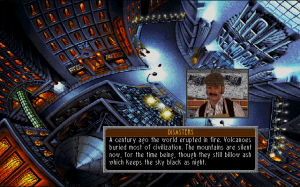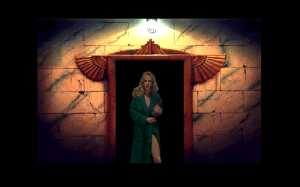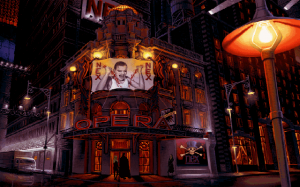Noctropolis 
It shouldn’t be controversial to suggest that big ideas need great talent to pull off. Richard Garriott nearly single-handedly created Ultima, but he was a designer of immense skill and vision. Not everyone can execute a game of that scale, and if you don’t have a capable team, the results will not match the scope its design.
Noctropolis is a notable casualty of a developer tackling an ambitious concept that it could never see to fruition. In an ideal world, Noctropolis would be a rollicking comic book adventure with high energy, snappy writing, and grand stakes. But that is not this game. Noctropolis is an endless series of failures and mistakes, a parade of terrible acting, nonsensical plotting, and unchecked psychopathy. Flashpoint Productions tried so hard to make the ultimate original adventure franchise, and wow, what a spectacular mess.
In Noctropolis, you play as Peter Grey, a failing comic book store owner on the verge of bankruptcy. Grey’s favorite comic is Darksheer, the story of an eponymous superhero who defends the Gotham-esque city of Noctropolis from ne’er-do-wells with the help of his catsuit-clad sidekick Stiletto. One evening, a package arrives from the Cygnus Publishing Group containing a special final edition of Darksheer. It’s a bleak issue, implying that Darksheer has vanished and that villainy has overtaken the city. When Grey finishes, a powerful and mysterious force sucks him into the world of the comic, stranding him in Noctropolis – and leaving him to take up the mantle of Darksheer.
The setting of Noctropolis is the best thing this game has going for it. Flashpoint Productions created a legitimately compelling and exciting original comic book world. The whole endeavor is derivative of Batman, but it carries enough unique character to differentiate itself as a dystopian alternative. The city resembles sort of a Gothic version of Blade Runner‘s Los Angeles, with towering skyscrapers, permanent night, and gargoyle overwatch. The oft-implied backstory is downright intriguing, with casual references to past cataclysms and glimpses of under-city ruins. Many unusual story elements, like the Oliver Twist-style child army known as the Wards, are intentionally underplayed and color the city’s vibrant background. Noctropolis‘s mythology gets support from some of the best visuals in the genre; its highly stylized cityscapes and urban labyrinths are constantly evocative and surprisingly pretty. And the music and sound effects, combining heroic bombast and mystery, are triumphant.
I want to emphasize how much potential exists in this elaborate and gorgeous world, if only to demonstrate how greatly disappointing it is that Noctropolis fails to make compelling use of it. The plot starts out strongly, delving into a conspiracy involving the Cygnus Construction company and a mysterious supervillain named Flux who is organizing Darksheer’s enemies for a final assault on the city. One by one, the city’s rogues, like the magician Tophat and the sadistic Master Macabre, emerge from the woodwork and trap you in perilous scenarios. This is typical pulpy material, but it fits the atmosphere perfectly. So much could happen in the world of Noctropolis, and you’ll enter every scene with crossed fingers and baited breath, hoping that maybe this one will make good on the promise made by its moodiness.
Sadly, in typical adventure genre fashion, the bulk of the game is composed of unintuitive or overly obtuse puzzles. There are hidden compartments and near-invisible items everywhere, and most dialogue trees require nonsensical answers to complete. To get past a robotic enemy guard, for instance, you have to find a hidden power cable, attach it to a makeshift spear taken from a nearby fence, and throw it like a javelin. Or, to get into a meeting with a member of Cygnus Construction, you need to know that it’s too warm in the building (no context clues suggest this) and that the company receptionist can be persuaded once the air conditioning is fixed. This feels awfully silly and out-of-character when you have grenades. Noctropolis excels best when you’re engaging in street gossip and exploration through dark alleys and crypts, activities that truly feel like adventurous detective work.
A game driven by setting can still succeed in terms of its story, but the game suffers more there. Noctropolis is, put simply, terribly written and poorly structured. Every line of dialogue is cliched, every villain one-dimensional. No one behaves believably, and the situations you encounter seem arbitrary and disconnected from the story, even when they’re central to it. The story progresses when you learn more each location around the city you can visit, but these various setpieces lack any connective tissue. You might have to visit the local opera house because you see one of their fliers on the sidewalk, but the game provides no real reason to head there while Flux’s villains terrorize the city. When the big bads do appear, they’re often too flimsy to enjoy, like the non-sequitur showdown with the Dreamler that just stops midway and is never mentioned again. The games lacks the narrative consistency needed to pull of such an ambitious premise. By the end, the plot goes expectedly off the rails, diving into mythology about elemental gods who watch over the city. It comes out of nowhere and really makes no sense.
I reserve the greatest criticism for the characters. Everyone in Noctropolis interacts through horrendous live-action cutscenes. The dialogue is embarrassing enough, but the actors are shockingly bad, even by contemporarily low FMV standards. Take the scene in which you visit a greenhouse and are terrorized by Greenthumb, an evil human-plant hybrid who snares you in poisonous vines. The conflict evokes genuine tension, but then Greenthumb speaks. He sounds like an unintelligible impression of Sesame Street’s Grover and is unintentionally hilarious. In about five seconds, the scene slides from exciting to dumb.
(The writing failures are really bizarre considering the strength of much of the incidental flavor text. Descriptions of in-game objects and transitions often inspire atmosphere and detail on-par with the visuals. The credits list a separate writer for “Screen Texts,” which might explain this discrepancy.)
Perhaps the most painful part of Noctropolis‘s writing is that Peter Grey is a dick. Adventure games and others with choose-your-own mechanics like Mass Effect frequently offer the option to be an aggressive jerk, but these are usually undesirable or at least strategic occurrences. In comparison, in Noctropolis, everything you do is obnoxious and horrible. Every character you interact with can be insulted without prompting. When you meet Noctropolis’s head record keeper, for example, you can either ineffectually attempt to gain his confidence or berate and belittle him for his career choice. Since the first option doesn’t work, you really have no choice but to try attacking him. Oftentimes, this is the only meaningfully way to interact with people. Darksheer is frequently spoken of in hushed reverence, but damn if Peter Grey doesn’t go out of his way to damage that reputation almost intentionally.
Worst of all, Peter Grey is sexist. Noxiously, overbearingly sexist. This problem filters through the entire game. It’s not a stretch to say that many games, particularly older ones, have issues with their portrayal of women, but Noctropolis goes above and beyond in its tone-deafness. Nearly every female character wears a revealing outfit and acts provocatively, and with limited exceptions, they can all be sexually harassed. In fact, based on the limited dialogue options available, harassing women is often actively encouraged and never taken seriously.
It’s pretty terrible, and sadly, the rest of the game takes a similar tact. The female villain Succubus, for instance, fights her opponents by raping them. The game handles that about as maturely as you’d expect; after Grey is sexually assaulted by Succubus, you’re told “Don’t dwell on it” by a priest. That’s really fucked up.
There’s no better expression of Noctropolis‘s bizarre sexism than Stiletto, your leather-clad sidekick. Twice in a row, seemingly impossible puzzles are solved by having her seduce your targets with babytalk. The seduction is embarrassing enough to watch the first time around, but the second time, it’s sort of insane. (These are further examples of how poorly designed most of the puzzles are.) Then, about two-thirds of the way into the game, Stiletto treats you to a live-action striptease as part of a dream sequence that has nothing to do with the rest of the game. After a harrowing escape from a madman’s underground lair – BOOM, striptease. At that moment, Noctropolis passes from awful to entertainingly awful then right over into awful again. The game has no idea what to do with female characters.
Stiletto’s presence is a detriment even beyond those cringe-worthy scenes. Following you around ostensibly as backup, Stiletto will often offer no advice and even insult you for turning to her. Normally in adventure games like this, you’d at least expect your sidekick to reflect on the situation or point out details. Not so much in Noctropolis: if she can’t seduce her way out of a problem, she’ll yell at you for asking for her help. Even more bafflingly, the game will find excuses to separate Stiletto from you, including one scene in which she off-handedly mentions that she has a headache and wants to stay outside. There’s absolutely no consistency to her inclusion, utility, or characterization.
Problems with characterization are rampant throughout Noctropolis. The buildup to Peter Grey’s assumption of the Darksheer persona is appropriately dramatic and weighty, but once you don the costume, nobody notices or cares. Grey has become a figure whose infamy and legend are seemingly the only thing holding the city together, yet when you confront average people on the street, they fail to recognize you. There is even a lengthy sidequest in which you pretend to be a safety compliance officer applying for a permit to inspect a new building – all while dressed in the Darksheer costume. Seriously?! It would be like The Dark Knight including a scene in which Batman (not Bruce Wayne, but Batman) applies for a small business loan.
More amusingly, the game sometimes outright forgets that certain events have happened. Stiletto first appears as a drunk has-been, holding up in her apartment ever since Darksheer vanished. Once she gets into her crime-fighting gear again and joins your side to clean up the city, you can still go back to her apartment and visit her in all her boozed-out, washed-up glory. It’s outrageously sloppy, stupid, and indicative of how few shits Noctropolis gives at times.
So Noctropolis is a huge failure, but it’s an exciting, insane failure. Flashpoint Studios clearly took on more than they could handle, and they filled the gaps in their talent with raw ambition and big ideas. Almost everything they tried – the episodic encounters with villains, the massive scale, the acting, and the original world – does not work. Yet the underlying atmosphere holds too much potential to discount the game entirely. Under normal circumstances, I would not recommend Noctropolis, but its total ineptitude in the face of its grand design is staggering and, frankly, entertaining. Playing it is a fascinating experiment in wondering what could have been. The world is beautiful, the sound design and music impeccable. But every other aspect of this game is eye-openingly bad. This is an incomparable, once-in-a-generation fiasco.
Trivia!
Noctropolis was designed by Brent Erickson, designer and producer of the first two Tex Murphy games. At least that explains the live-action talking heads.






I love this game but I agree with pretty much everything said here. I suspect development was rushed at the end and you were, for example, originally not supposed to be wearing the superhero outfit while interacting with certain characters. That could have been a fun dynamic, your sidekick waiting around the corner with both your outfits stashed for you to finish your building inspector or homicide investigator impressions until it’s time to kick some doors down.
I never encountered Stiletto back at her apartment once she fully joined up, though.
Here’s another review that goes into greater detail about this game:
http://www.pcgamer.com/saturday-crapshoot-noctropolis/
I’m still annoyed that Noctropolis isn’t the moody, gothic superhero story it presents itself as. All that atmospheric art direction, wasted.